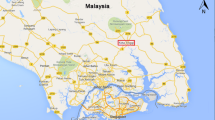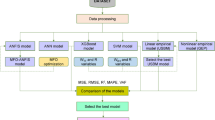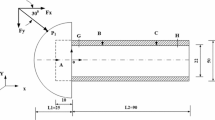Abstract
The idea of using long barrels in weapon systems provides a significant advantage in terms of superiority against targets moving at high speed. However, the use of long barrels in weapon systems has a disadvantage in terms of target precision. In particular, the ability to use multiple and different ammunition in a weapon system causes the barrel dynamics to be different for each ammunition. This situation makes it even more difficult to control muzzle vibrations. In this study, the adaptive neural-fuzzy model was designed to estimate the vibrations at the tip of an antiaircraft barrel, considering different ammunition. The sample sets used for training and testing the adaptive neural-fuzzy model were obtained using the finite element method, taking into account the dynamic interaction between the accelerated projectile and the barrel. The performance of the adaptive neural-fuzzy model created has been tested with the cases created by considering the different membership function numbers. Apart from this, the performance of the adaptive neural-fuzzy model is compared with artificial neural networks, and the results are given in a table. With the adaptive neural-fuzzy model, the mean square error value obtained by using test patterns was 0.002, the correlation coefficient R2 value was 0.9998, and the mean error percentage value was 1.6. As a result, it has been proven that adaptive neural-fuzzy outperforms ANN in predicting barrel tip vibrations.









Similar content being viewed by others
References
Madhevan, B.; Sakkaravarthi, R.; Singh, G.; Diya, R.; Jha, D.: Modelling, simulation and mechatronics design of a wireless automatic fire fighting surveillance robot. Def. Sci. J. 67, 572–580 (2017). https://doi.org/10.14429/dsj.67.10237
Nadda, S.; Swarup, A.: Tracking control design for quadrotor unmanned aerial vehicle. Def. Sci. J. 67, 245–253 (2017). https://doi.org/10.14429/dsj.67.9536
Koide, R.M.; Ferreira, A.P.C.S.; Luersen, M.A.: Laminated Composites Buckling Analysis Using Lamination Parameters, Neural Networks and Support Vector Regression. Lat. Am. J. Solids Struct. 12, 271–294 (2014)
Lagaros, N.D.; Papadrakakis, M.: Neural network based prediction schemes of the non-linear seismic response of 3D buildings. Adv. Eng. Softw. 44, 92–115 (2012). https://doi.org/10.1016/j.advengsoft.2011.05.033
Martínez-Martínez, V.; Gomez-Gil, F.J.; Gomez-Gil, J.; Ruiz-Gonzalez, R.: An Artificial Neural Network based expert system fitted with Genetic Algorithms for detecting the status of several rotary components in agro-industrial machines using a single vibration signal. Expert Syst. Appl. 42, 6433–6441 (2015). https://doi.org/10.1016/j.eswa.2015.04.018
Perez-Ramirez, C.A.; Amezquita-Sanchez, J.P.; Adeli, H.; Valtierra-Rodriguez, M.; Camarena-Martinez, D.; Romero-Troncoso, R.J.: New methodology for modal parameters identification of smart civil structures using ambient vibrations and synchrosqueezed wavelet transform. Eng. Appl. Artif. Intell. 48, 1–12 (2016). https://doi.org/10.1016/j.engappai.2015.10.005
Altınkaya, H.; Orak, İM.; Esen, İ: Artificial neural network application for modeling the rail rolling process. Expert Syst. Appl. 41, 7135–7146 (2014). https://doi.org/10.1016/j.eswa.2014.06.014
Ağbulut, Ü.; Ayyıldız, M.; Sarıdemir, S.: Prediction of performance, combustion and emission characteristics for a CI engine at varying injection pressures. Energy 197, 117257 (2020). https://doi.org/10.1016/j.energy.2020.117257
Liennard, M.; Chevalier, O.; Langlet, A.; Guilmard, Y.; Bailly, P.: Influence of the gun barrel straightness on projectile exit conditions. 22ème Congrès Français de Mécanique (2015)
Tatar, A.B.; Taşar, B.; Yakut, O.: A shooting and control application of four-legged robots with a gun turret. Arab. J. Sci. Eng. 45, 5191–5206 (2020). https://doi.org/10.1007/s13369-020-04339-3
Dong, X.; Rui, X.; Li, C.; Wang, Y.; Fan, L.: A calculation method of interior ballistic two-phase flow considering the recoil of gun barrel. Appl. Therm. Eng. 185, 116239 (2021). https://doi.org/10.1016/j.applthermaleng.2020.116239
Dursun, T.; Büyükcivelek, F.; Utlu, Ç.: A review on the gun barrel vibrations and control for a main battle tank. Def. Technol. 13, 353–359 (2017). https://doi.org/10.1016/j.dt.2017.05.010
Shanmugamani, R.; Sadique, M.; Ramamoorthy, B.: Detection and classification of surface defects of gun barrels using computer vision and machine learning. Meas. J. Int. Meas. Confed. 60, 222–230 (2015). https://doi.org/10.1016/j.measurement.2014.10.009
Hosseini, M.; Dalvand, A.: Neural network approach for estimation of penetration depth in concrete targets by ogive-nose steel projectiles. 492–506 (2014)
Sarkar, A.K.; Vathsal, S.; Sundaram, S.; Mukhopadhay, S.: Target acceleration estimation from radar position data using neural network. Def. Sci. J. 55, 313–328 (2005). https://doi.org/10.14429/dsj.55.1995
Goztepe, K.: Designing a battlefield fire support system using adaptive neuro-fuzzy inference system based model. Def. Sci. J. 63, 497–501 (2013). https://doi.org/10.14429/dsj.63.3716
Yadav, A.; Gaur, P.: Neuro-fuzzy-based ımproved IMC for speed control of nonlinear heavy duty vehicles. Def. Sci. J. 66, 665–672 (2016). https://doi.org/10.14429/dsj.66.9489
Esen, I.; Koç, M.A.: Optimization of a passive vibration absorber for a barrel using the genetic algorithm. Expert Syst. Appl. (2015). https://doi.org/10.1016/j.eswa.2014.08.038
Moayedi, H.; Raftari, M.; Sharifi, A.; Jusoh, W.A.W.; Rashid, A.S.A.: Optimization of ANFIS with GA and PSO estimating α ratio in driven piles. Eng. Comput. 36, 227–238 (2020). https://doi.org/10.1007/s00366-018-00694-w
Kumar Singh, N.; Singh, Y.; Sharma, A.; Kumar, S.: Diesel engine performance and emission analysis running on jojoba biodiesel using intelligent hybrid prediction techniques. Fuel 279, 118571 (2020). https://doi.org/10.1016/j.fuel.2020.118571
Hsiao, Y.-T.; Chuang, C.-L.; Jiang, J.-A.; Chien, C.-C.: A novel optimization algorithm: space gravitational optimization. In: Conference Proceedings - IEEE International Conference on Systems, Man and Cybernetics. pp. 2323–2328 (2005)
Littlefield, A.; Kathe, E.; Messier, R.; Olsen, K.: Gun barrel vibration absorber to increase accuracy. New York (2002)
Büyükcivelek, F.: Analysis and control of gun barrel vibrations. 159 (2011)
Fryba, L.: Vibration solids and structures under moving loads. Thomas Telford House (1999)
Gawronski, W.K.: Advanced dynamics and active control of structures. (2004)
Mızrak, C.; Esen, İ: The optimisation of rail vehicle bogie parameters with the fuzzy logic method in order to improve passenger comfort during passage over bridges. Int. J. Heavy Veh. Syst. 24, 113 (2017). https://doi.org/10.1504/IJHVS.2017.083057
Jang, J.S.R.: ANFIS: adaptive-network-based fuzzy inference system. IEEE Trans. Syst. Man Cybern. 23, 665–685 (1993). https://doi.org/10.1109/21.256541
Ewees, A.A.; Aziz, M.A.E.; Elhoseny, M.: Social-spider optimization algorithm for improving ANFIS to predict biochar yield. In: 2017 8th International Conference on Computing, Communication and Networking Technologies (ICCCNT). pp. 1–6 (2017)
Ahmed, K.; Ewees, A.A.; Abd El Aziz, M.; Hassanien, A.E.; Gaber, T.; Tsai, P.W.; Pan, J.S.: A hybrid krill-ANFIS model for wind speed forecasting. Adv. Intell. Syst. Comput. 533, 365–372 (2017)
Alameer, Z.; Elaziz, M.A.; Ewees, A.A.; Ye, H.; Jianhua, Z.: Forecasting copper prices using hybrid adaptive neuro-fuzzy inference system and genetic algorithms. Nat. Resour. Res. 28, 1385–1401 (2019). https://doi.org/10.1007/s11053-019-09473-w
Al-qaness, M.A.A.; Abd Elaziz, M.; Ewees, A.A.; Cui, X.: A modified adaptive neuro-fuzzy ınference system using multi-verse optimizer algorithm for oil consumption forecasting. Electronics (2019). https://doi.org/10.3390/electronics8101071
Koç, M.A.; Esen, İ; Çay, Y.: Tip deflection determination of a barrel for the effect of an accelerating projectile before firing using finite element and artificial neural network combined algorithm. Lat. Am. J. Solids Struct. 13, 1968–1995 (2016). https://doi.org/10.1590/1679-78252718
Nalbant, M.; Gokkaya, H.; Toktaş, I.: Comparison of regression and artificial neural network models for surface roughness prediction with the cutting parameters in CNC turning. Model. Simul. Eng. (2007). https://doi.org/10.1155/2007/92717
González, B.; Valdez, F.; Melin, P.; Prado-Arechiga, G.: Fuzzy logic in the gravitational search algorithm for the optimization of modular neural networks in pattern recognition. Expert Syst. Appl. 42, 5839–5847 (2015). https://doi.org/10.1016/j.eswa.2015.03.034
Cay, Y.: Prediction of a gasoline engine performance with artificial neural network. Fuel 111, 324–331 (2013). https://doi.org/10.1016/j.fuel.2012.12.040
Web reference 1: https://en.wikipedia.org/wiki/120%C3%97570mm_NATO
Web reference 2: https://tr.wikipedia.org/wiki/Oerlikon_GDF-003
Author information
Authors and Affiliations
Corresponding author
Rights and permissions
About this article
Cite this article
Koç, M.A. Development of an Intelligent Software Based on Adaptive Neural-Fuzzy Inference Systems for Predicting Muzzle Vibration of a Gun Barrel. Arab J Sci Eng 47, 8829–8846 (2022). https://doi.org/10.1007/s13369-021-06425-6
Received:
Accepted:
Published:
Issue Date:
DOI: https://doi.org/10.1007/s13369-021-06425-6




